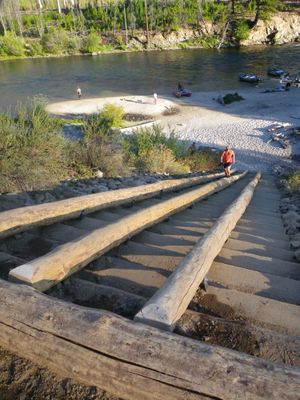Indian Creek boat ramp revamped on Middle Fork Salmon
RIVER RUNNING -- Whitewater boaters are putting in their names before the Jan. 31 deadline for drawing dates to run Idaho's famous wilderness whitewater rivers, including the Selway, Hells Canyon of the Snake, Salmon and Middle Fork Salmon.
Of course, rivers change on their own each year from natural forces, but Middle Fork rafters will see nifty improvement.
The Selway-Bitterroot Frank Church Foundation partnered with the U.S. Forest Service in September to recronstruct the Middle Fork's Indian Creek boat ramp.The previous ramp constructed in 2006 fell victim to exposure and wood rot after supporting countless rafts on the 75-foot descent from the public air strip to the river.
More than 10,000 people float the iconic Middle Fork each year, and a large number of those users choose to fly into Indian Creek and use the boat ramp to launch when the water is either high or low. The ramp is also an integral component for outfitters who fly clients in for trips.
The Selway-Bitterroot Frank Church Foundation recruited ten volunteers from Idaho, Montana and Colorado to replace the ramp in its entirety, effectively installing a new boat ramp. The work consisted of manually deconstructing and hauling the old ramp to an off-site location, then reinstalling each new step and slide log by hand.
About12,000 pounds of timber was moved by hand during the demolition and reinstallation.
Read on for more details.
The Forest Service chose to use eight inch by eight inch square treated timbers to replace the previous native log steps that had rotten and become unsafe. Each new step was placed using string lines to ensure accuracy and was triple checked for plumb and level.
Re-bar pins in each step to the ground and native lodge pole logs bolted to the steps act as slide rails to support rafts on the steep hillside descent to the river.very 5-6 years becomes much easier, not to mention you cut down on pinning your slide rails with re-bar that eventually rots and catches on boats. The new straps rest under each rail, away from boats and unsuspecting toes. Oh, and don't worry, we hand filed all the edges of the straps so there are NO SHARP EDGES!!
No power tools or mechanical devices were used during this project. Instead, traditional tools such as auger drills, cross-cut saws, double jack hammers and volunteer elbow grease provided all the power required for a project of this magnitude.
This project was made possible by funding provided by the Southwest Idaho RAC and support from the Salmon-Challis National Forest and our volunteers.
The Selway-Bitterroot Frank Church Foundation is a local non-profit organization dedicated to connecting citizens and communities to assist in the stewardship of the Frank Church-River of No Return Wilderness, Selway-Bitterroot Wilderness, and surrounding wildlands. They are a non-political and non-advocacy partner of the US Forest Service in helping to take care of trails, weeds, trash, historic structures and educate the next generation of wilderness stewards.

